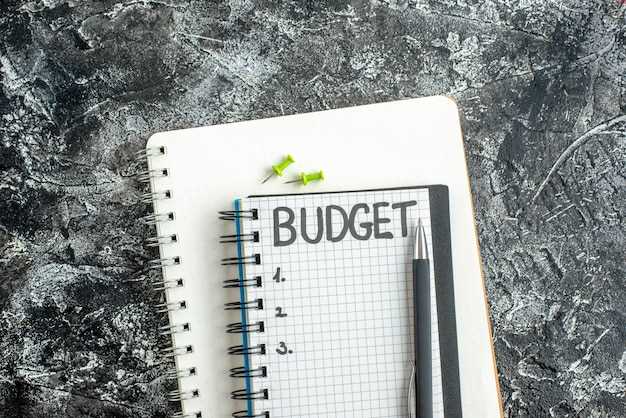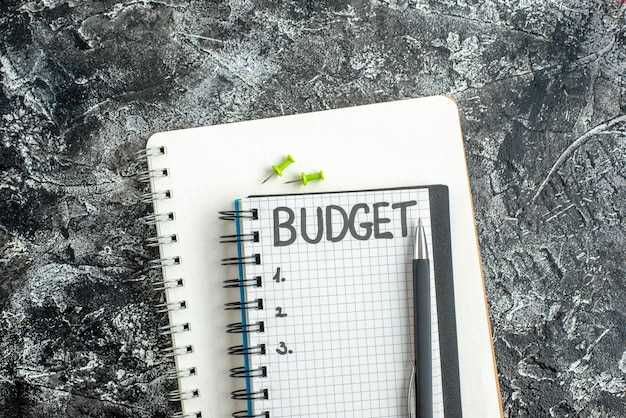Effective budget management is crucial for both individuals and organizations to achieve their financial goals. By establishing a clear budget plan and sticking to it, you can manage your resources more efficiently and safeguard against unexpected financial challenges. This article explores proven strategies that can help you create, maintain, and optimize your budget to ensure financial stability and growth.
Understanding Your Financial Goals is the first step in any budget management process. Whether you’re aiming to save for a major purchase, pay off debt, or invest in future opportunities, knowing what you’re working towards can provide direction and motivation. A well-defined goal helps streamline your budgeting efforts and keeps you focused on the bigger picture.
Next, tracking your income and expenses is essential for gaining a comprehensive view of your financial landscape. Utilize tools and apps to meticulously record every transaction, no matter how small. This practice not only highlights your spending habits but also identifies areas where you can cut costs and reallocate funds more effectively.
Creating a realistic budget plan involves balancing your income against your essential and non-essential expenditures. Structure your budget in such a way that it covers all necessary expenses, such as housing, utilities, and groceries, while also allowing room for discretionary spending. Flexibility within your budget can accommodate unforeseen expenses and prevent financial strain.
Regularly reviewing and adjusting your budget ensures it remains aligned with your financial situation and goals. Periodic assessment allows you to make necessary adjustments based on changes in income, expenses, or financial priorities. This continuous monitoring creates a more resilient and adaptable financial plan.
Finally, implementing automated saving and investing strategies can significantly boost your budget’s effectiveness. Automating savings transfers to a dedicated account or setting up regular investment contributions can help you build wealth without conscious effort, making it easier to stick to your financial plan and achieve long-term goals.
In conclusion, mastering budget management requires a combination of goal setting, diligent tracking, realistic planning, regular reviews, and automated financial habits. By incorporating these strategies into your financial routine, you can gain control over your finances and pave the way for a secure and prosperous future.
Mastering Money Management Techniques

Effective money management is crucial for achieving financial stability and meeting both short-term and long-term goals. Here are several key techniques to master for efficient money management:
Create a Detailed Budget: Start with a comprehensive budget that outlines all your income sources and expenses. Track spending meticulously to identify areas where you can cut costs.
Prioritize Expenses: Differentiate between essential and non-essential expenses. Allocate funds to necessities like housing, utilities, and groceries first. This ensures you cover your basic needs before spending on discretionary items.
Build an Emergency Fund: Set aside money in a separate account to cover unexpected expenses, such as medical bills or car repairs. An emergency fund provides financial security and prevents reliance on credit.
Practice Debt Management: Focus on paying down high-interest debt as quickly as possible. Consider using strategies like the snowball method (paying off smallest debts first) or the avalanche method (paying off highest interest rate debts first) to reduce overall debt efficiently.
Automate Savings: Automate transfers to savings accounts or investment portfolios. By setting up automatic contributions, you ensure consistent saving habits without having to manually deposit money each month.
Track Financial Goals: Set clear, measurable financial goals. Whether it’s saving for a vacation, a down payment on a house, or retirement, having specific targets helps you stay motivated and focused.
Review and Adjust Regularly: Regularly review your budget and financial situation. Adjust your spending and saving strategies based on changes in income, expenses, or financial goals to maintain effective money management.
Mastering these money management techniques puts you in control of your finances, helping you make informed decisions, reduce stress, and achieve financial success.
Creating a Practical Spending Plan

Effective budget management starts with a practical spending plan. This plan serves as a roadmap for how to allocate financial resources to meet both short-term needs and long-term goals.
First, identify all sources of income. This includes not only wages but also any additional forms of revenue such as investments, rental income, or freelance work. Knowing your total income is essential for setting realistic expenditure limits.
Next, categorize your expenses. Divide them into fixed and variable costs. Fixed costs include rent, mortgage payments, utility bills, and loan repayments. These are non-negotiable and must be prioritized. Variable costs include groceries, dining out, entertainment, and discretionary spending. Categorizing helps in understanding where most of your money is going and identifying possible areas for reduction.
Establish spending limits for each category based on your income and financial goals. Be specific and realistic while setting these limits. Overly restrictive budgets can be difficult to stick to and may lead to financial stress.
Track your spending consistently. Use budgeting tools or apps to monitor your daily expenses. This ongoing tracking allows for adjustments in real time and helps prevent overspending.
Regularly review and adjust your spending plan. Financial situations and priorities can change over time. Conduct monthly or quarterly reviews to ensure your budget remains aligned with your current financial landscape and goals.
Automate savings and essential payments. Set up automatic transfers to your savings account and schedule payments for fixed costs. Automation reduces the likelihood of missed payments and helps in building a savings cushion.
A practical spending plan is a dynamic tool that requires attention and adjustment. With proper planning, tracking, and reviewing, it enables effective budget management and financial stability.
Assessing Your Income and Expenses
Proper budget management begins with a thorough assessment of your income and expenses. Understanding the flow of money in and out of your financial ecosystem is essential for making informed decisions and creating a sustainable budget plan.
Determine Your Income Sources: List all sources of income, including salary, bonuses, freelance work, rental income, and any other earnings. It’s crucial to account for both primary and secondary income streams. Make sure to document the net amounts after taxes and other deductions.
Track Your Expenses: Categorize your expenses into fixed and variable costs. Fixed expenses include rent or mortgage payments, insurance premiums, and loan repayments. Variable expenses encompass groceries, utilities, entertainment, and other discretionary spending. Use tools like spreadsheets or budget tracking apps to record each transaction accurately.
Identify Spending Patterns: Review several months of transaction data to identify spending patterns and habits. Look for areas where expenses can be reduced or optimized. Recognizing habitual overspending in certain categories enables targeted adjustments to curb unnecessary costs.
Calculate Your Disposable Income: Subtract total monthly expenses from total monthly income to determine your disposable income. This amount represents the funds available for savings, investments, and discretionary spending. A clear picture of your disposable income helps prioritize financial goals.
Regularly review and adjust your budget: Financial circumstances can change, so it’s essential to regularly review and adjust your budget. Monitor changes in income and expenses to ensure that your budget remains realistic and achievable. Adapting to evolving financial situations helps maintain financial stability.
Setting Achievable Financial Goals
Defining clear and attainable financial goals is crucial for effective budget management. By setting realistic objectives, individuals and businesses can create a roadmap for their financial future. Here are key steps to ensure your financial goals are both achievable and beneficial:
-
Identify Priorities:
Establish what is most important to you financially, whether it’s saving for a house, reducing debt, or building an emergency fund.
-
Set Specific Targets:
Instead of vague goals like “save money”, define exact amounts and time frames, such as “save $10,000 for a down payment in two years.”
-
Ensure Goals are Measurable:
Determine how you will track your progress. Create benchmarks and use tools like budgeting apps or spreadsheets to monitor your savings and expenditures.
-
Break Down Larger Goals:
Divide bigger objectives into smaller, manageable tasks. For example, if saving for retirement, set yearly or monthly saving targets.
-
Adjust for Changes:
Life circumstances can change. Be prepared to reassess and modify your goals as needed to stay realistic and achievable.
-
Prioritize Debt Reduction:
High-interest debt can undermine your financial goals. Focus on paying off high-interest debts to free up more resources for other objectives.
-
Automate Savings:
Set up automatic transfers to savings accounts. This ensures you’re consistently working towards your savings goals without having to think about it.
By following these steps, you will be better equipped to set financial goals that are realistic and tailored to your needs, enhancing your overall budget management strategy.
Building and Following a Budget
Creating and adhering to a budget is crucial for effective financial management and achieving financial goals. The following guide outlines the essential steps to build and maintain a budget.
- Define Financial Goals: Determine short-term and long-term objectives such as saving for a vacation, paying off debt, or building an emergency fund.
- Assess Income: Calculate monthly take-home pay from all sources to understand the total available funds.
- Track Expenses: Monitor all expenditures for a month or two to identify spending patterns and categorize expenses as fixed or variable.
- Create Spending Categories: Develop categories such as housing, utilities, transportation, groceries, entertainment, and savings.
- Allocate Funds: Assign portions of your income to each spending category based on priority and necessity.
To effectively follow your budget:
- Use Budgeting Tools: Utilize spreadsheets, apps, or software to track and update your budget regularly.
- Review and Adjust: Periodically revisit and tweak your budget to reflect changes in income, expenses, or financial goals.
- Limit Discretionary Spending: Exercise self-control with non-essential purchases to stay within budget limits.
- Automate Savings: Set up automatic transfers to savings accounts to ensure consistent contributions.
- Stay Committed: Maintain discipline and motivation by reminding yourself of the benefits of staying on budget.
Building and following a budget requires dedication, but it is a powerful tool for managing finances wisely and achieving financial stability.
Implementing Savvy Saving Methods

Effective budget management requires not only tracking expenses but also adopting clever saving methods. Implementing savvy saving methods can significantly impact your financial health. Below are practical strategies to help you save more effectively:
| Method | Description | Benefit |
|---|---|---|
| Automate Savings | Set up automatic transfers to your savings account. | Ensures consistent savings without relying on memory or discipline. |
| Use Cash-Back Rewards | Opt for credit or debit cards that offer cash-back incentives. | Earn money back on purchases you are already making. |
| Negotiate Bills | Contact service providers to renegotiate bills like internet or insurance. | Potentially reduce your recurring expenses. |
| Utilize Price Matching | Take advantage of stores’ price matching policies. | Get the best price available for goods without having to shop around. |
| Buy in Bulk | Purchase non-perishable items in large quantities. | Lower cost per unit and reduce the frequency of purchases. |
By integrating these methods into your financial routine, you can optimize your budget and increase your savings effortlessly.
Cutting Down Unnecessary Costs
One of the most effective strategies for managing a budget is to identify and reduce unnecessary costs. This involves a thorough review of all expenses and making strategic decisions to cut or eliminate those that do not provide significant value to the business. Below are several areas where costs can often be reduced without impacting the overall productivity or quality of work.
| Category | Potential Reduction Strategies |
|---|---|
| Office Supplies | Bulk purchasing, switching to generic brands, reducing paper usage |
| Utilities | Implement energy-saving measures, switch to energy-efficient appliances |
| Travel Expenses | Utilize virtual meeting tools, book flights and hotels in advance, consider economy options |
| Subscriptions | Review all subscriptions for necessity, cancel unused services |
| Marketing | Focus on digital marketing, use cost-effective channels, measure ROI for all marketing activities |
| Salaries | Optimize workforce, offer flexible working arrangements, consider part-time or freelance staff |
Regular audits of expenditures and maintaining awareness of where money is being spent are crucial for keeping costs down. Additionally, fostering a culture of cost-efficiency within the organization can lead to more innovative ways to manage and reduce expenses.
Utilizing Savings Tools and Accounts
Effective budget management often involves leveraging various savings tools and accounts to maximize financial growth and security. Savings accounts are essential for creating an emergency fund and earning interest on deposited funds. Consider opting for high-yield savings accounts which offer higher interest rates compared to traditional savings accounts.
An Individual Retirement Account (IRA) can be effective for long-term savings goals. IRAs come in two primary types: Traditional and Roth. Contributions to a Traditional IRA may be tax-deductible, thereby lowering your taxable income for the year. Roth IRAs, on the other hand, allow tax-free withdrawals during retirement, provided certain conditions are met.
Certificate of Deposits (CDs) offer higher interest rates than standard savings accounts in exchange for locking away your money for a specified period. Although they are less liquid, they provide a secure way to grow savings with minimal risk.
Utilizing money market accounts can also be an effective strategy. These accounts often come with higher interest rates compared to regular savings accounts and may offer limited check-writing privileges. However, they might require a higher minimum balance to avoid fees.
Finally, consider using automated savings tools. Many banks offer automatic transfer services which move a specified amount of money from your checking to your savings account regularly. This strategy helps in building savings consistently without requiring manual effort.
By wisely utilizing these savings tools and accounts, you can create a robust financial plan that aligns with both short-term and long-term goals.
Maximizing Discounts and Offers
One of the most effective budget management strategies is taking full advantage of discounts and special offers. Here are several ways to maximize these opportunities:
-
Sign Up for Newsletters: Many retailers offer exclusive discounts and early access to sales for newsletter subscribers. This can be a great way to stay informed about upcoming promotions.
-
Use Cashback and Coupon Apps: Apps like Rakuten, Honey, and various cashback services can provide significant savings by applying coupons or returning a percentage of your purchase.
-
Compare Prices Online: Before making a purchase, use price comparison websites to ensure you’re getting the best deal available. Websites like PriceGrabber and Google Shopping can be very useful.
-
Join Loyalty Programs: Joining customer loyalty programs can lead to further discounts and reward points that can be redeemed for future purchases.
-
Take Advantage of Seasonal Sales: Timing your purchases around seasonal sales can result in significant savings. Common sales periods include Black Friday, Cyber Monday, and end-of-season clearances.
-
Bulk Buying: Purchasing in bulk can often lower the unit price of products. This is particularly beneficial for non-perishable items like toiletries and household goods.
-
Negotiate Prices: In certain situations, particularly with big-ticket items, you can negotiate for a better price or additional discounts. Don’t hesitate to ask retailers if there are any available promotions or discounts.
By integrating these techniques into your purchasing strategy, you can effectively reduce expenses and manage your budget more efficiently.
Video:
ACCOUNTANT EXPLAINS: Money Habits Keeping You Poor
ACCOUNTANT EXPLAINS: Money Habits Keeping You Poor by Nischa 9,857,009 views 1 year ago 8 minutes, 6 seconds
Q&A:
What are some practical steps to start with effective budget management?
Starting with effective budget management involves several key steps. First, analyze your current financial situation by tracking income and expenses. Next, set clear financial goals—for example, saving for a house, paying off debt, or building an emergency fund. Create a realistic budget by categorizing your expenses into fixed (rent, utilities) and variable (groceries, entertainment) costs. Allocate a percentage of your income to each category while ensuring you save a portion. Regularly review and adjust your budget as needed.
How can one stick to a budget without feeling too restricted?
Sticking to a budget doesn’t have to feel restrictive. One effective strategy is to create a flexible budget that includes discretionary spending for non-essential items you enjoy. Consider using the 50/30/20 rule where 50% goes to needs, 30% to wants, and 20% to savings and debt repayment. This way, you’re not cutting out all fun expenses. Also, track your spending to identify any areas where minor adjustments can provide more flexibility. Lastly, periodically reward yourself for sticking to your budget without derailing your financial goals.
What tools can help me manage my budget more efficiently?
There are several tools that can help manage your budget more efficiently. Budgeting apps like Mint, YNAB (You Need a Budget), and PocketGuard help track expenses and income, categorize spending, and set financial goals. Spreadsheet programs like Microsoft Excel or Google Sheets offer customizable templates for detailed budget tracking. Additionally, personal finance software such as Quicken provides comprehensive budgeting solutions, including investment tracking and bill management. Utilizing these tools can help you stay organized and make informed financial decisions.
How do emergency funds fit into budget management strategies?
Emergency funds are a critical component of any effective budget management strategy. They provide a financial cushion for unexpected expenses such as medical emergencies, car repairs, or job loss. Ideally, you should aim to save three to six months’ worth of living expenses in an easily accessible savings account. Building an emergency fund should be prioritized in your budget, allocating a portion of your monthly income until the desired amount is saved. This ensures you have the funds to cover unforeseen circumstances without disrupting your overall financial plan.
What are common budgeting mistakes and how can I avoid them?
Common budgeting mistakes include not tracking expenses, underestimating spending, ignoring debt, and not adjusting the budget for life changes. To avoid these issues, diligently track all your expenses and compare them against your budget regularly. Be realistic about your spending habits and account for every category, including irregular expenses like holidays or car maintenance. Focus on paying down high-interest debt as a priority. Lastly, revisit and adjust your budget whenever significant life changes occur, such as a new job, relocation, or changes in household size, to ensure it remains relevant and effective.
What is zero-based budgeting and how can it be effectively implemented in a small business?
Zero-based budgeting (ZBB) is a method where every expense must be justified for each new period, starting from zero rather than building on the previous period’s budget. This method encourages businesses to scrutinize every cost and allocate funds based on current needs and priorities rather than historical expenditures. For small businesses, implementing ZBB effectively starts with identifying all cost drivers and understanding their necessity. Create detailed cost-benefit analyses for each expense and involve all departments in the process to ensure comprehensive accountability. Additionally, adopt financial software that can simplify tracking and justifying expenses, allowing for a more dynamic and responsive budgeting process.
